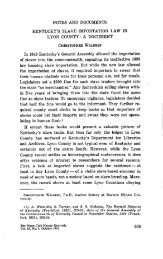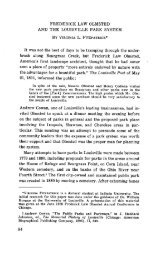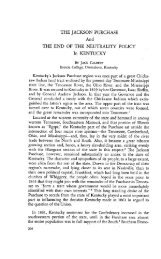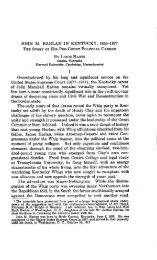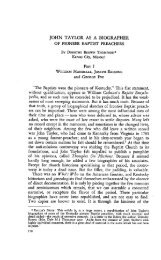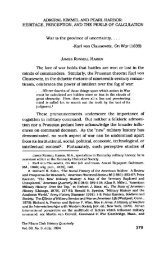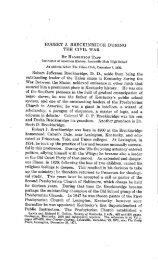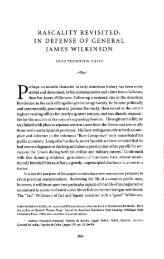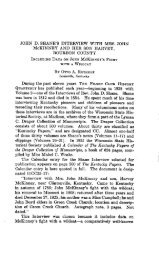Eskippakithiki, The Last Indian Town in Kentucky - The Filson ...
Eskippakithiki, The Last Indian Town in Kentucky - The Filson ...
Eskippakithiki, The Last Indian Town in Kentucky - The Filson ...
Create successful ePaper yourself
Turn your PDF publications into a flip-book with our unique Google optimized e-Paper software.
358 <strong>The</strong> <strong>Filson</strong> Club Hislory Quarterly [Vol. 6<br />
Before the white man reached America, the savage Algonquians,<br />
who had not yet lost their northern hard<strong>in</strong>ess, had been<br />
hurl<strong>in</strong>g themselves aga<strong>in</strong>st the Easterners--sedentary Siouans<br />
and the Iroquoians--until, <strong>in</strong> their desperation, five tribes of the<br />
latter, about 1570, formed the confederacy known as the Five<br />
Nations, the most efficient <strong>in</strong> eastern North America. Gett<strong>in</strong>g<br />
guns from the Dutch, about 1630-1640, many years before the<br />
<strong>Indian</strong>s of the <strong>in</strong>terior received them, they turned on their tormentors<br />
and crushed them. In their raids <strong>in</strong>to the west they<br />
reached the Shawnees about 1655 and, accord<strong>in</strong>g to Charlevoix,<br />
conquered them by 1672.<br />
By the second half of the seventeenth century many Shawnees<br />
had made their way up the southern branches of the Ohio, where<br />
they built their towns of Chaskepe and Meguachaika on a river<br />
which is called on Franquel<strong>in</strong>'s map of 1684 the "Skipaki cipi ou<br />
Riviere bleue," which is either the Red or the Lick<strong>in</strong>g River. <strong>The</strong><br />
topography and dra<strong>in</strong>age of the Ohio Valley were not understood<br />
<strong>in</strong> those long-ago days and the old maps are so badly scrambled<br />
that it too often is impossible to he certa<strong>in</strong> about locations or the<br />
modern equivalents of their obsolete names. In 1673, while on<br />
the Mississippi pass<strong>in</strong>g the mouth of the Ohio, Marquette notes<br />
that the Ohio is "<strong>in</strong>habited by a people called Chaouanons<br />
[French spell<strong>in</strong>g of Shawnees] <strong>in</strong> such numbers that they reckon<br />
25 villages <strong>in</strong> one district and 15 <strong>in</strong> another, ly<strong>in</strong>g quite near to<br />
each other."<br />
Consider<strong>in</strong>g the date and the sources from which Franquel<strong>in</strong><br />
compiled his map and that the country north of the Ohio had been<br />
swept almost clean of <strong>in</strong>habitants by this time, the settlements<br />
referred to by Marquette must have been those towns on the Skipaki<br />
cipi <strong>in</strong> <strong>Kentucky</strong>. In the same account we axe given a<br />
glimpse of the effect of the Iroquois' raids on the southern <strong>Indian</strong>s,<br />
for he says: "and because these poor people can not defend themselves<br />
[not hav<strong>in</strong>g firearms], they allow themselves to be captured<br />
and taken like flocks of sheep; and, <strong>in</strong>nocent though they are, they<br />
nevertheless sometimes experience the barbarity of the Iroquois,<br />
who cruelly burn them."<br />
That the Shawnees were not nerveless cowards, their whole<br />
after-history pr0claSms., From 1655 to 1815, for one hundred and<br />
sixty years, they were always at war; and from 1755 to the end of<br />
the War of 1812, for sixty years, they were the backbone of the



